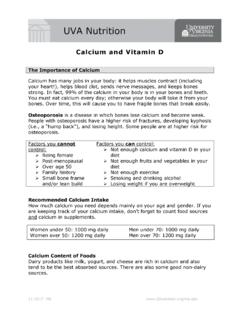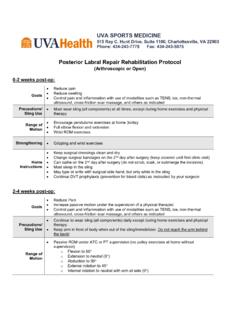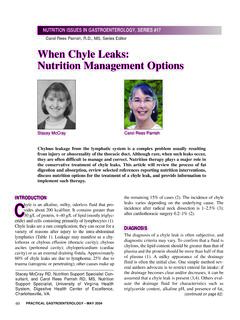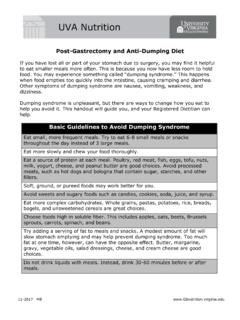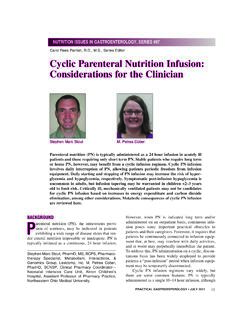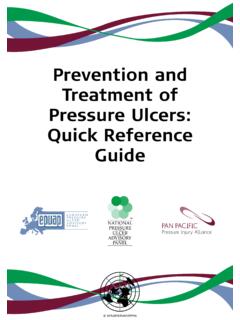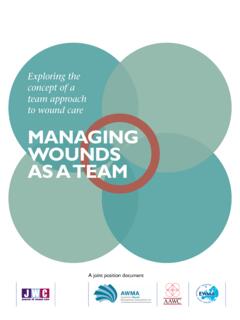Transcription of DIFFERENTIATE RED EYE DISORDERS - University of Virginia ...
1 Needs immediate treatment Needs treatment within a few days Does not require treatment Introduction DIFFERENTIATE RED EYE DISORDERS SUBJECTIVE EYE COMPLAINTS Decreased vision Pain Redness Characterize the complaint through history and exam. Introduction TYPES OF RED EYE DISORDERS Mechanical trauma Chemical trauma Inflammation/infection Introduction ETIOLOGIES OF RED EYE 1. Chemical injury 2. Angle-closure glaucoma 3. Ocular foreign body 4. Corneal abrasion 5. Uveitis 6. Conjunctivitis 7. Ocular surface disease 8. Subconjunctival hemorrhage Introduction RED EYE: POSSIBLE CAUSES Trauma Chemicals Infection Allergy Systemic conditions Evaluation RED EYE: CAUSE AND EFFECT Symptom Cause Itching Allergy Burning Lid DISORDERS , dry eye Foreign body sensation Foreign body, corneal abrasion Localized lid tenderness Hordeolum, chalazion Evaluation RED EYE: CAUSE AND EFFECT (Continued) Symptom Cause Deep, intense pain Corneal abrasions, scleritis, iritis, acute glaucoma, sinusitis, etc.
2 Photophobia Corneal abrasions, iritis, acute glaucoma Halo vision Corneal edema (acute glaucoma, uveitis) Evaluation Evaluation Equipment needed to evaluate red eye Refer red eye with vision loss to ophthalmologist for evaluation Evaluation RED EYE DISORDERS : AN ANATOMIC APPROACH Face Adnexa Orbital area Lids Ocular movements Globe Conjunctiva, sclera Anterior chamber (using slit lamp if possible) Intraocular pressure Evaluation DISORDERS of the Ocular Adnexa DISORDERS of the Ocular Adnexa Hordeolum DISORDERS of the Ocular Adnexa DISORDERS of the Ocular Adnexa Chalazion HORDEOLUM/CHALAZION: TREATMENT Goal To promote drainage Treatment Acute/subacute: Warm-hot compresses, tid Chronic.
3 Refer to ophthalmologist DISORDERS of the Ocular Adnexa BLEPHARITIS Inflammation of lid margin Associated with dry eyes Seborrhea causes dried skin and wax on base of lashes May have Staphylococcal infection Symptoms: lid burning, lash mattering DISORDERS of the Ocular Adnexa DISORDERS of the Ocular Adnexa Collarettes on eyelashes of patient with blepharitis BLEPHARITIS: TREATMENT Lid and face hygiene Warm compresses to loosen deposits on lid margin Gentle scrubbing with nonirritating shampoo or scrub pads Artificial tears to alleviate dry eye Antibiotic or antibiotic-corticosteroid ointment Oral doxycycline 100 mg daily for refractory cases DISORDERS of the Ocular Adnexa DISORDERS of the Ocular Adnexa Preseptal cellulitis DISORDERS of the Ocular Adnexa Orbital cellulitis External signs: redness, swelling Motility impaired, painful Proptosis Often fever and leukocytosis Optic nerve.
4 Decreased vision, afferent pupillary defect, disc edema DISORDERS of the Ocular Adnexa ORBITAL CELLULITIS: SIGNS AND SYMPTOMS ORBITAL CELLULITIS: MANAGEMENT Hospitalization Ophthalmology consult Eye consult Blood culture Orbital CT scan ENT consult if pre-existing sinus disease DISORDERS of the Ocular Adnexa ORBITAL CELLULITIS: TREATMENT IV antibiotics stat: Staphylococcus, Streptococcus, H. influenzae Surgical debridement if fungus, no improvement, or subperiosteal abscess Complications: cavernous sinus thrombosis, meningitis DISORDERS of the Ocular Adnexa Lacrimal System DISORDERS Lacrimal system Lacrimal System DISORDERS Dacryocystitis NASOLACRIMAL DUCT OBSTRUCTION: CONGENITAL Massage tear sac daily Probing, irrigation, if chronic Systemic antibiotics if infected Lacrimal System DISORDERS NASOLACRIMAL DUCT OBSTRUCTION.
5 ACQUIRED Trauma a common cause Systemic antibiotics if infected Surgical procedure after one episode of dacryocystitis (dacryocystorhinostomy) prn Lacrimal System DISORDERS Ocular Surface DISORDERS Ocular Surface DISORDERS Dilated conjunctival blood vessels ADULT CONJUNCTIVITIS: MAJOR CAUSES Bacterial Viral Allergic Ocular Surface DISORDERS CONJUNCTIVITIS: DISCHARGE Discharge Cause Purulent Bacterial Clear Viral* Watery, with stringy; white mucus Allergic** Ocular Surface DISORDERS * Preauricular lymphadenopathy signals viral infection ** Itching often accompanies BACTERIAL CONJUNCTIVITIS: COMMON CAUSES Staphylococcus (skin) Streptococcus (respiratory) Haemophilus (respiratory) Ocular Surface DISORDERS BACTERIAL CONJUNCTIVITIS TREATMENT Topical antibiotic: qid x 7 days (aminoglycoside, erythromycin, fluoroquinolone, sulfacetamide, or trimethoprim-polymyxin) Warm compresses Refer if not markedly improved in 3 days Ocular Surface DISORDERS Ocular Surface DISORDERS Copious purulent discharge: Suspect Neisseria gonorrhoeae.
6 Ocular Surface DISORDERS Viral conjunctivitis VIRAL CONJUNCTIVITIS Watery discharge Highly contagious Palpable preauricular lymph node History of URI, sore throat, fever common Ocular Surface DISORDERS If pain, photophobia, or decreased vision, refer. Ocular Surface DISORDERS Allergic conjunctivitis ALLERGIC CONJUNCTIVITIS Associated conditions: hay fever, asthma, eczema Contact allergy: chemicals, cosmetics, pollen Treatment: topical antihistamine/decongestant drops Systemic antihistamines if necessary for systemic disease Refer refractory cases. Ocular Surface DISORDERS NEONATAL CONJUNCTIVITIS: CAUSES Bacteria (N.)
7 Gonorrhoeae, 2 4 days) Bacteria (Staphylococcus, Streptococcus, 3 5 days) Chlamydia (5 12 days) Viruses (eg, herpes, from mother) Ocular Surface DISORDERS Ocular Surface DISORDERS Neonatal gonococcal conjunctivitis Ocular Surface DISORDERS Neonatal chlamydial conjunctivitis NEONATAL CHLAMYDIAL CONJUNCTIVITIS: TREATMENT Erythromycin ointment: qid x 4 weeks Erythromycin po x 2 3 weeks 40 50 mg/kg/day 4 Ocular Surface DISORDERS Ocular Surface DISORDERS Subconjunctival hemorrhage TEARS AND DRY EYES Tear functions: Lubrication Bacteriostatic and immunologic functions Dry eye (keratoconjunctivitis sicca) is a tear deficiency state Ocular Surface DISORDERS TEAR DEFICIENCY STATES: SYMPTOMS Burning Foreign-body sensation Paradoxical reflex tearing Symptoms can be made worse by reading, computer use, television, driving, lengthy air travel Ocular Surface DISORDERS TEAR DEFICIENCY STATES: ASSOCIATED CONDITIONS Aging Rheumatoid arthritis Stevens-Johnson syndrome Chemical injuries Ocular pemphigoid Systemic medications Ocular Surface DISORDERS DRY EYES.
8 TREATMENT Artificial tears, cyclosporine drops Nonpreserved artificial tears Lubricating ointment at bedtime Punctal occlusion Counseling about activities that make dry eyes worse Ocular Surface DISORDERS Ocular Surface DISORDERS Thyroid exophthalmos: one cause of exposure keratitis EXPOSURE KERATITIS: CAUSES AND MANAGEMENT Due to incomplete lid closure Manage with lubricating solutions/ointments Tape lids shut at night Do not patch Refer severe cases Ocular Surface DISORDERS Ocular Surface DISORDERS Pinguecula Ocular Surface DISORDERS Pterygium INFLAMED PINGUECULA AND PTERYGIUM: MANAGEMENT Artificial tears Counsel patients to avoid irritation If documented growth or vision loss, refer Ocular Surface DISORDERS Anterior Segment DISORDERS Anterior Segment DISORDERS ACUTE CORNEAL DISORDERS .
9 SYMPTOMS Eye pain Foreign-body sensation Deep and boring Photophobia Blurred vision Anterior Segment DISORDERS Anterior Segment DISORDERS Irregular corneal light reflex and central corneal opacity Anterior Segment DISORDERS Fluorescein dye strip applied to the conjunctiva Anterior Segment DISORDERS Corneal abrasion, stained with fluorescein and viewed with cobalt blue light CORNEAL ABRASION Signs and symptoms: redness, tearing, pain, photophobia, foreign-body sensation, blurred vision, small pupil Causes: injury, welder s arc, contact lens overwear Anterior Segment DISORDERS CORNEAL ABRASION: MANAGEMENT Goals: Promote rapid healing Relieve pain Prevent infections Treatment.
10 1% cyclopentolate Topical antibiotics Drops (eg, fluoroquinolone, others) or ointment (eg, erythromycin, bacitracin/polymyxin) pressure patch x 24 48 hours Oral analgesics Anterior Segment DISORDERS Anterior Segment DISORDERS Applying a pressure patch CHEMICAL INJURY A true ocular emergency Requires immediate irrigation with nearest source of water Management depends on offending agent Anterior Segment DISORDERS Anterior Segment DISORDERS Chemical burn: acid Anterior Segment DISORDERS Chemical burn: alkali Corneal ulcer Giant papillary conjunctivitis Anterior Segment DISORDERS INFECTIOUS KERATITIS Frequently result from mechanical trauma Can cause permanent scarring and decreased vision Early detection, aggressive therapy are vital Anterior Segment DISORDERS Anterior Segment DISORDERS Bacterial infection of the cornea Anterior Segment DISORDERS Primary herpes simplex infection Anterior Segment DISORDERS Corneal herpes simplex dendrites, stained with fluorescein Rx Topical Anesthetics Anterior Segment DISORDERS TOPICAL STEROIDS.

